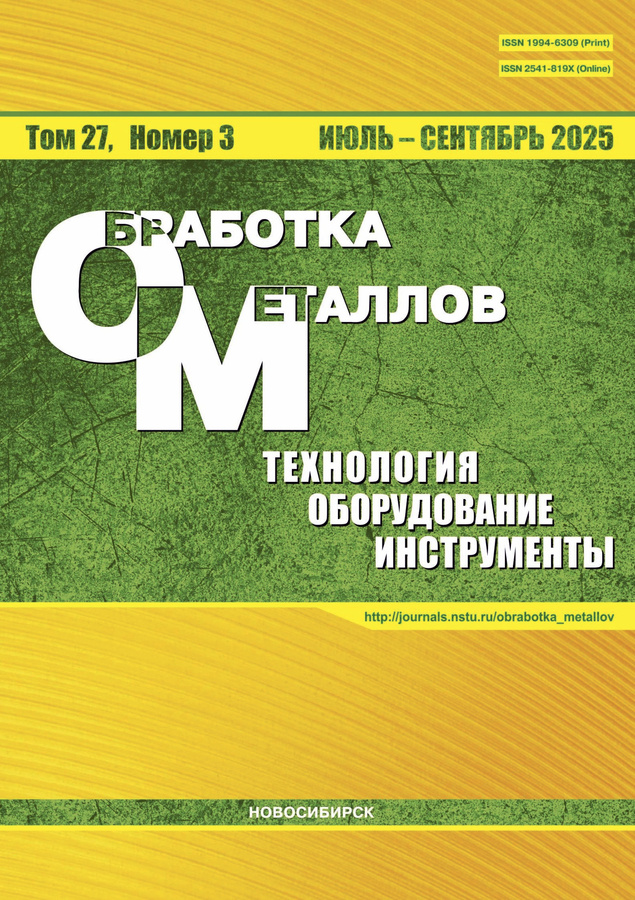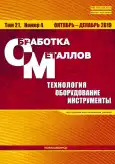Закономерности формирования материалов с композитной структурой с использованием аддитивной электронно-лучевой технологии, сварки трением с перемешиванием и фрикционной перемешивающей обработки
- Авторы: Калашникова Т.А.1, Гусарова А.В.1, Чумаевский А.В.1, Княжев Е.О.1, Шведов М.А.1, Васильев П.А.1
-
Учреждения:
- Выпуск: Том 21, № 4 (2019)
- Страницы: 94-112
- Раздел: МАТЕРИАЛОВЕДЕНИЕ
- URL: https://ogarev-online.ru/1994-6309/article/view/302054
- DOI: https://doi.org/10.17212/1994-6309-2019-21.4-94-112
- ID: 302054
Цитировать
Полный текст
Аннотация
Об авторах
Т. А. Калашникова
Email: gelombang@ispms.tsc.ru
Институт физики прочности и материаловедения СО РАН, пр. Академический, 2/4, г. Томск, 634055, Россия, gelombang@ispms.tsc.ru
А. В. Гусарова
Email: gusarova@ispms.ru
Институт физики прочности и материаловедения СО РАН, пр. Академический, 2/4, г. Томск, 634055, Россия, gusarova@ispms.ru
А. В. Чумаевский
Email: tch7av@gmail.com
канд. техн. наук, Институт физики прочности и материаловедения СО РАН, пр. Академический, 2/4, г. Томск, 634055, Россия, tch7av@gmail.com
Е. О. Княжев
Email: zhenya4825@gmail.com
Национальный исследовательский Томский политехнический университет, пр. Ленина, 30, г. Томск 634050, Россия, zhenya4825@gmail.com
М. А. Шведов
Email: shved1951@rambler.ru
канд. техн. наук, Чувашский государственный университет им. И.Н. Ульянова, пр. Московский ,15, г. Чебоксары, 428015, Россия, shved1951@rambler.ru
П. А. Васильев
Email: svarkacheb@yandex.ru
Чувашский государственный университет им. И.Н. Ульянова, пр. Московский ,15, г. Чебоксары, 428015, Россия, svarkacheb@yandex.ru
Список литературы
- Adhesion transfer in sliding a steel ball against an aluminum alloy / S.Yu. Tarasov, A.V. Filippov, E.A. Kolubaev, T.A. Kalashnikova // Tribology International. – 2017. – Vol. 115. – P. 191–198.
- Towards aging in a multipass friction stir–processed АА2024 / K.N. Kalashnikov, S.Yu. Tarasov, A.V. Chumaevskii, S.V. Fortuna, A.A. Eliseev, A.N. Ivanov // International Journal of Advanced Manufacturing Technology. – 2019. – Vol. 103 (5–8). – P. 2121–2132. – doi: 10.1007/s00170-019-03631-3.
- Abbasi M., Givi M., Bagheri B. Application of vibration to enhance efficiency of friction stir processing // Transactions of Nonferrous Metals Society of China. – 2019. – Vol. 29 (7). – P. 1393–1400. – doi: 10.1016/S1003-6326(19)65046-6.
- Review of friction stir processing of magnesium alloys / R.A. Kumar, S. Ramesh, E.S. Kedarvignesh, M.S.A. Arulchelvam, S. Anjunath // Materials Today: Proceedings. – 2019. – Vol. 16 (2). – P. 1320–1324. – doi: 10.1016/j.matpr.2019.05.230.
- Ma Z.Y. Friction stir processing technology: a review // Metallurgical and Materials Transactions A. – 2008. – Vol. 39 (3). – P. 642–658. – doi: 10.1007/s11661-007-9459-0.
- Reactive mechanism and mechanical properties of in-situ hybrid nano-composites fabricated from an Al–Fe2O3 system by friction stir processing / G. Azimi-Roeen, S.F. Kashani-Bozorg, M. Nosko, P. Švec // Materials Characterization. – 2017. – Vol. 127. – P. 279–287.
- Influence of multi-pass friction stir processing on wear behaviour and machinability of an Al-Si hypoeutectic A356 alloy / S.K. Singh, R.J. Immanuel, S. Babu, S.K. Panigrahi, G.D. Janaki Ram // Journal of Materials Processing Technology. – 2016. – Vol. 236. – P. 252–262. – doi: 10.1016/j.jmatprotec.2016.05.019.
- Cast aluminium matrix composites modified with using FSP process – changing of the structure and mechanical properties / P. Kurtyka, N. Rylko, T. Tokarski, A. Wójcicka, A. Pietras // Composite Structures. – 2015. – Vol. 133. – P. 959–967.
- Tarasov S.Yu., Rubtsov V.E., Kolubaev E.A. A proposed diffusion-controlled wear mechanism of alloy steel friction stir welding (FSW) tools used on an aluminum alloy // Wear. – 2014. – Vol. 318 (1–2). – P. 130–134.
- Ultrasonic-assisted aging in friction stir welding on Al-Cu-Li-Mg aluminum alloy / S.Yu. Tarasov, V.E. Rubtsov, S.V. Fortuna, A.A. Eliseev, A.V. Chumaevsky, T.A. Kalashnikova, E.A. Kolubaev // Welding in the World. – 2017. – Vol. 61 (4). – P. 679–690.
- Tarasov S.Yu., Rubtsov V.E., Kolubaev E.A., Gnyusov S.F., Kudinov Yu.A. Radioscopy of remnant joint line in a friction stir welded seam // Russian Journal of Nondestructive Testing. – 2015. – Vol. 51 (9). – P. 573–579.
- Friction-stir welding of ultra-fine grained sheets of Al-Mg-Sc-Zr alloy / S. Malopheyev, S. Mironov, V. Kulitskiy, R. Kaibyshev // Materials Science and Engineering: A. – 2015. – Vol. 624. – P. 132–139.
- Superplasticity of friction-stir welded Al-Mg-Sc sheets with ultrafine-grained microstructure / S. Malopheyev, S. Mironov, I. Vysotskiy, R. Kaibyshev // Materials Science and Engineering: A. – 2016. – Vol. 649. – P. 85–92.
- Friction-stir welding of an Al-Mg-Sc-Zr alloy in as-fabricated and work-hardened conditions / S. Malopheyev, V. Kulitskiy, S. Mironov, D. Zhemchuzhnikova, R. Kaibyshev // Materials Science and Engineering: A. – 2014. – Vol. 600. – P. 159–170.
- Fullerene/A5083 composites fabricated by material flow during friction stir processing / Y. Morisada, H. Fujii, T. Nagaoka, K. Nogi, M. Fukusumi // Composites Part A: Applied Science and Manufacturing. – 2007. – Vol. 38. – P. 2097–2101. – doi: 10.1016/j.compositesa.2007.07.004.
- Lee C.J., Huang J.C. High strain rate superplasticity of Mg based composites fabricated by friction stir processing // Materials Transactions. – 2006. – Vol. 47. – P. 2773–2778.
- Microstructure and mechanical property of nano-SiCp reinforced high strength Mg bulk composites produced by friction stir processing / K. Sun, Q.Y. Shi, Y.J. Sun, G.Q. Chen // Materials Science and Engineering: A. – 2012. – Vol. 547. – P. 32–37.
- Dixit M., Newkirk J.W., Mishra R.S. Properties of friction stir-processed Al 1100-NiTi composite // Scripta Materialia. – 2007. – Vol. 56. – P. 541–544.
- Fabrication and mechanical properties of bulk NiTip/Al composites prepared by friction stir processing / D.R. Ni, J.J. Wang, Z.N. Zhou, Z.Y. Ma // Journal of Alloys and Compounds. – 2014. – Vol. 586. – P. 368–374.
- Microstructure and mechanical property of multi-walled carbon nanotubes reinforced aluminum matrix composites fabricated by friction stir processing / Q. Liu, L. Ke, F. Liu, C. Huang, L. Xing // Materials and Design. – 2013. – Vol. 45. – P. 343–348.
- A novel way to produce bulk SiCp reinforced aluminum metal matrix composites by friction stir processing / W. Wang, Q.-Y. Shi, P. Liu, H.-K. Li, T. Li // Journal of Materials Processing Technology. – 2009. – Vol. 209. – P. 2099–2103.
- Fabrication of a new Al-Al2O3-CNTs composite using friction stir processing (FSP) / Z. Du, M.J. Tan, J.F. Guo, G. Bi, J. Wei // Materials Science and Engineering: A. – 2016. – Vol. 667. – P. 125–131.
- Additive manufacturing of metallic components – process, structure and properties / T. Debroy, H.L. Wei, J.S. Zuback, T. Mukherjee, J.W. Elmer, J.O. Milewski, A.M. Beese, A. Wilson-Heid, A. De, W. Zhang // Progress in Materials Science. – 2018. – Vol. 92. – P. 112–224. – doi: 10.1016/j.pmatsci.2017.10.001.
- Additive manufacturing of metals: a brief review of the characteristic microstructures and properties of steels, Ti-6Al-4V and high-entropy alloys / S. Gorsse, C. Hutchinson, M. Gouné, R. Banerjee // Science and Technology of Advanced Materials. – 2017. – Vol. 18 (1). – P. 1–27.
- Progress in additive manufacturing on new materials: a review / N. Li, S. Huang, G. Zhang, R. Qin, W. Liu, H. Xiong, G. Shi, J. Blackburn // Journal of Materials Science and Technology. – 2019. – Vol. 35 (2). – P. 242–269.
- Basak A., Das S. Epitaxy and microstructure evolution in metal additive manufacturing // Annual Review of Materials Research. – 2016. – Vol. 46. – P. 125–149.
- Design of novel materials for additive manufacturing – isotropic microstructure and high defect tolerance / J. Günther, F. Brenne, M. Droste, M. Wendler, O. Volkova, H. Biermann, T. Niendorf // Scientific Reports. – 2018. – Vol. 8. – P. 1–14.
- Wang Z., Palmer T.A., Beese A.M. Effect of processing parameters on microstructure and tensile properties of austenitic stainless steel 304L made by directed energy deposition additive manufacturing // Acta Materialia. – 2016. – Vol. 110. – P. 226–235.
- Characterization of wire arc additively manufactured titanium aluminide functionally graded material: microstructure, mechanical properties and oxidation behavior / J. Wang, Z. Pan, Y. Ma, Y. Lu, C. Shen, D. Cuiuri, H. Li // Materials Science and Engineering: A. – 2018. – Vol. 734. – P. 110–119.
- Liu W.P., DuPont J.N. Fabrication of functionally graded TiC/Ti composites by laser engineered net shaping // Scripta Materialia. – 2003. – Vol. 48 (9). – P. 1337–1342.
- Effect of heat input on phase content, crystalline lattice parameter, and residual strain in wire-feed electron beam additive manufactured 304 stainless steel / S.Yu. Tarasov, A.V. Filippov, N.L. Savchenko, S.V. Fortuna, V.E. Rubtsov, E.A. Kolubaev, S.G. Psakhie // International Journal of Advanced Manufacturing Technology. – 2018. – Vol. 99 (9–12). – P. 2353–2363.
- The Features of structure formation in chromium-nickel steel manufactured by a wire-feed electron beam additive process / A.V. Kolubaev, S.Yu. Tarasov, A.V. Filippov, Yu.A. Denisova, E.A. Kolubaev, A.I. Potekaev // Russian Physics Journal. – 2018. – Vol. 61 (8). – P. 1491–1498.
- Microstructural evolution and chemical corrosion of electron beam wire-feed additively manufactured AISI 304 stainless steel / S.Yu. Tarasov, A.V. Filippov, N.N. Shamarin, S.V. Fortuna, G.G. Maier, E.A. Kolubaev // Journal of Alloys and Compounds. – 2019. – Vol. 803. – P. 364–370.
- Fabrication of large Ti-6Al-4V structures by direct laser deposition / C.L. Qiu, G.A. Ravi, C. Dance, A. Ranson, S. Dilworth, M.M. Attallah // Journal of Alloys and Compounds. – 2015. – Vol. 629. – P. 351–361.
- Heat-treated microstructure and mechanical properties of laser solid forming Ti-6Al-4V alloy / S.Y. Zhang, X. Lin, J. Chen, W.D. Huang // Rare Metals. – 2009. – Vol. 28 (6). – P. 537–544.
- Dinda G.P., Song L., Mazumder J. Fabrication of Ti-6Al-4V scaffolds by direct metal deposition // Metallurgical and Materials Transactions A. – 2008. – Vol. 39 (12). – P. 2914–2922.
- Edwards P., O’;Conner A., Ramulu M. Electron beam additive manufacturing of titanium components: properties and performance // Journal of Manufacturing Science and Engineering. – 2013. – Vol. 135 (6). – P. 061016.
- Comparison of the microstructures and mechanical properties of Ti-6Al-4V fabricated by selective laser melting and electron beam melting / X. Zhao, S. Li, M. Zhang, Y. Liu, T.B. Sercombe, S. Wang, Y. Hao, R. Yang, L.E. Murr // Materials and Design. – 2016. – Vol. 95. – P. 21–31.
- Phase constituent control and correlated properties of titanium aluminide intermetallic alloys through dual-wire arc additive manufacturing / J. Wang, Z. Pan, D. Cuiuri, H. Li // Materials Letters. – 2019. – Vol. 242. – P. 111–114.
- Functionally graded material of 304L stainless steel and inconel 625 fabricated by directed energy deposition: characterization and thermodynamic modeling / B.E. Carroll, R.A. Otis, J.P. Borgonia, J.O. Suh, R.P. Dillon, A.A. Shapiro, D.C. Hofmann, Z. Liu, A.M. Beese // Acta Materialia. – 2016. – Vol. 108. – P. 46–54.
- Articek U., Milfelner M., Anzel I. Synthesis of functionally graded material H13/Cu by LENS technology // Advances in Production Engineering and Management. – 2013. – Vol. 8 (3). – P. 169–176. – doi: 10.14743/apem2013.3.164.
- Kahlen F.J., Klitzing A. von, Kar A. Hardness, chemical, and microstructural studies for laser-fabricated metal parts of graded materials // Journal of Laser Applications. – 2000. – Vol. 12 (5). – P. 205–209.
- Kayg?s?z Y. Microstructure characterization and hardness of Al-Cu-Mn eutectic alloy // China Foundry. – 2018. – Vol. 15 (5). – P. 390–396. – doi: 10.1007/s41230-018-7225-0.
- Formation of Al2Cu and AlCu intermetallics in Al(Cu) alloy matrix composites by reaction sintering / M. Aravind, P. Yu, M.Y. Yau, D.H.L. Ng // Materials Science and Engineering: A. – 2004. – Vol. 380 (1–2). – P. 384–393. – doi: 10.1016/j.msea.2004.04.013.
- Mixed mode I / II crack growth investigation for bi-metal FSW aluminum alloy AA7075-T6 / pure copper joints / M.R.M. Aliha, M.H. Kalantari, S.M.N. Ghoreishi, A.R. Torabi, S. Etesam // Theoretical and Applied Fracture Mechanics. – 2019. – Vol. 103. – P. 102243. – doi: 10.1016/j.tafmec.2019.102243.
Дополнительные файлы







